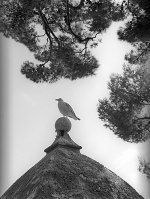mfogiel
Veteran
I have three 645 cameras: Bronica RF, Contax 645 and Pentax 645N, all fantastic photographic tools, but...
All of them to some extent, and particularly Bronica RF create vertical vignetting on my images whenever I expose a tad more generously. This is particularly evident with low latitude films, like Acros, but it even happens with Tri X. The vignetting runs along the long side of the negative ( which means across the film) so it cannot be from light fogging the film from the outside, and in any case you would expect stray light to create a denser negative, thus a "white vignetting". Here, the effect is opposite: a darker edge looking like dodging on the final image, but it feels like "fogged" in the sense, that all details are uniformly darker. I do not recall anything similar happening with any other format camera I've ever used.
I attach a frame on Tri X exposed for the shadows, where this effect is quite striking. Anybody has a good explanation?
All of them to some extent, and particularly Bronica RF create vertical vignetting on my images whenever I expose a tad more generously. This is particularly evident with low latitude films, like Acros, but it even happens with Tri X. The vignetting runs along the long side of the negative ( which means across the film) so it cannot be from light fogging the film from the outside, and in any case you would expect stray light to create a denser negative, thus a "white vignetting". Here, the effect is opposite: a darker edge looking like dodging on the final image, but it feels like "fogged" in the sense, that all details are uniformly darker. I do not recall anything similar happening with any other format camera I've ever used.
I attach a frame on Tri X exposed for the shadows, where this effect is quite striking. Anybody has a good explanation?







